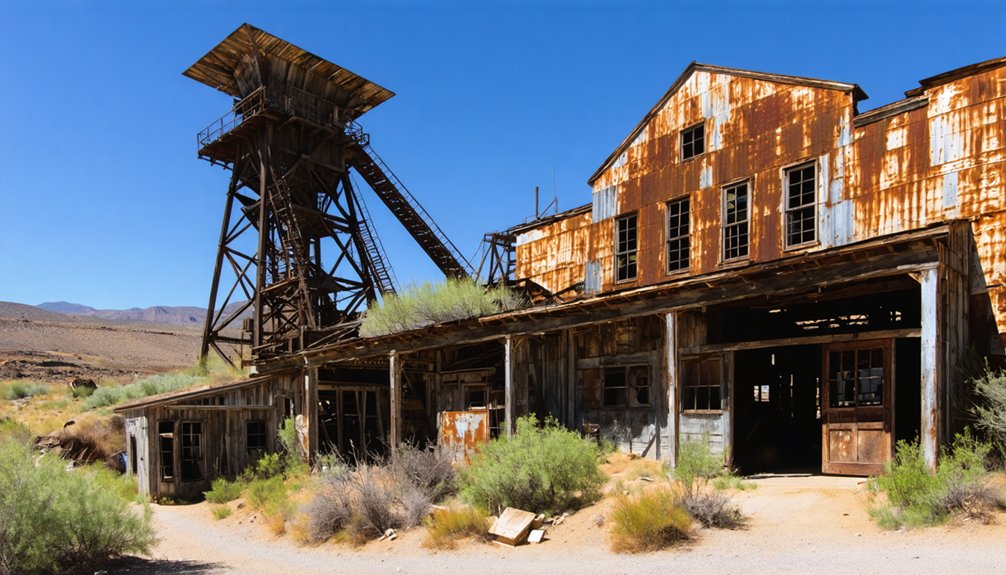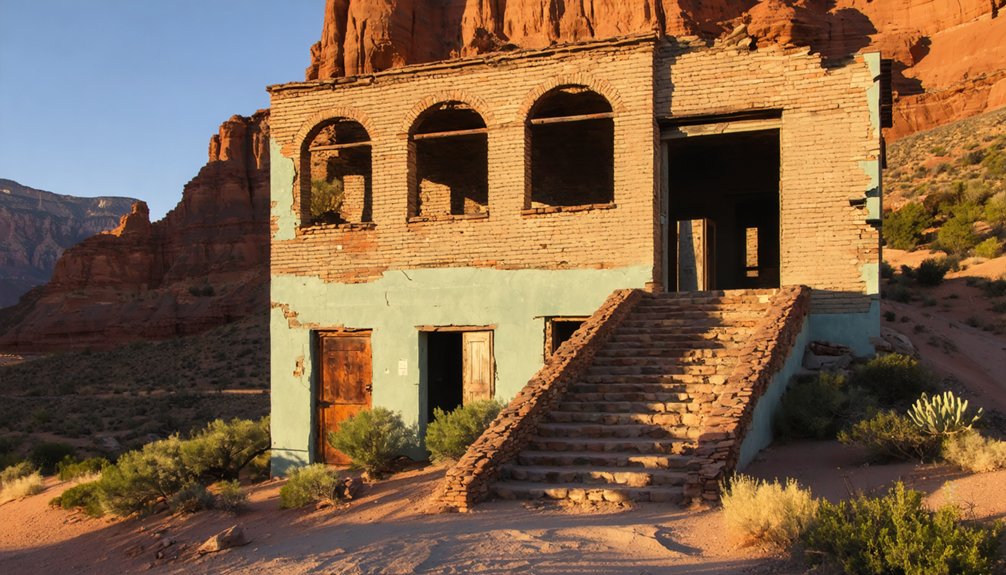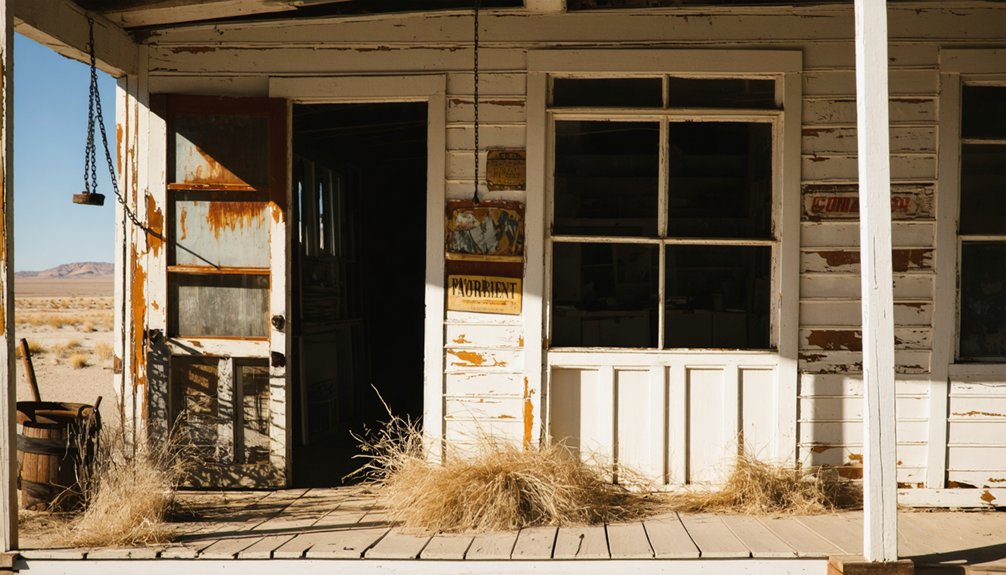Jerome, Arizona (not Geronimo) is an iconic ghost town clinging to Cleopatra Hill where copper mining once generated nearly a billion dollars before operations ceased in 1953. You’ll find a transformed community that survived near-abandonment when artists moved into vacant structures during the 1960s. The town features over 30 art galleries, haunted buildings, and 90 miles of abandoned mining tunnels beneath your feet. Its paranormal reputation draws visitors year-round.
Key Takeaways
- Geronimo led Apache groups that were displaced during Arizona’s mining boom in the late 19th century.
- His resistance against mining encroachment in Arizona territories coincided with Jerome’s copper industry development.
- While Jerome became a ghost town after mining operations ceased in 1953, it has no direct connection to Geronimo himself.
- Jerome’s transformation from ghost town to artistic community preserved structures from the era of Native displacement.
- The “Ghost City” nickname for Jerome relates to paranormal activity rather than to Geronimo’s Apache heritage.
The Rise and Fall of a Mining Powerhouse
When copper deposits were discovered on Cleopatra Hill in the 1870s, few could have predicted the meteoric rise and eventual collapse of what would become one of Arizona Territory’s most significant mining operations.
Prospectors McKinnon and Ruffner staked the first claims in 1876, attracting Eastern investors who formed the United Verde Copper Company. By 1890, over 300 men operated the coke-fueled smelter, yielding impressive daily profits of $1,500-$2,000. After initial success, the company faced financial troubles due to high operational costs and folded in less than two years.
The birth of a mining empire: prospectors, Eastern capital, and smokestacks yielding fortune from Arizona’s copper-rich hills.
William Clark’s narrow gauge railroad revolutionized the copper economy by reducing transportation costs.
As mining technology advanced, Jerome flourished with a population exceeding 2,500 by 1900, boasting electric lighting and civic buildings. The town, once dubbed the “wickedest town in America” by the San Francisco Examiner in 1899, survived multiple catastrophic fires as it rebuilt itself repeatedly. The mines yielded nearly 3 billion pounds of copper until operations ceased in 1953, victim to depleted reserves and volatile markets.
Jerome’s billion-dollar legacy transformed from bustling mining center to ghost town.
Life in the Copper Boom Years
As a miner in Geronimo during the copper boom, you’d face perilous daily descents into shafts while working for William Clark, the “Copper King” whose United Verde operation transformed the area from a tent settlement to a thriving town.
You’d earn about three dollars for a ten-hour shift, sufficient compensation for the dangerous conditions that claimed numerous lives through cave-ins, explosions, and respiratory diseases. Much like Saint Jerome’s asceticism, miners endured harsh physical conditions while pursuing what they believed was their calling.
Despite these hazards, you’d find camaraderie among the diverse workforce of over 30 nationalities who populated the saloons, fraternal organizations, and cultural institutions that defined the town’s vibrant, if notoriously wickedest town in America social landscape.
Dangerous Descent Daily
Perched precariously on the steep northeast slope of Cleopatra Hill, the copper mining town of Jerome embodied daily danger for its residents and workers during the boom years.
You’d face constant hazards just moving through town, as the intense slope and unstable ground triggered frequent rockslides and structural failures.
As a miner, your daily descent into tunnels meant confronting geological instability, toxic dust, extreme heat, and inadequate safety measures.
Even after electrical lighting arrived in 1890, the dangerous conditions persisted underground.
The steep slopes complicated transportation, with ore initially moved by mule trains on treacherous paths before narrow gauge railways were established.
Despite generating immense wealth—over a billion dollars in copper during its 70-year run—Jerome’s physical environment remained unforgiving, shaping its notorious reputation as America’s “Wickedest Town.”
The mining town of Jerome shared a similar fate to Clarkdale, with operations eventually ceasing when no viable ore remained to extract.
Copper King’s Court
The dangerous landscape that defined Jerome’s mining operations formed the backdrop for a dramatic economic transformation throughout the Arizona Territory.
You’d have witnessed William A. Clark’s copper wealth reshape the region after his strategic $80,000 purchase of United Verde Copper Company in 1888.
While you explored these boomtowns, you’d notice the stark contrasts—narrow-gauge railroads cutting through rugged terrain while miners endured hazardous conditions underground.
The mining legacy brought prosperity but also instability as copper prices fluctuated, triggering shutdowns and layoffs.
Daily life balanced opportunity with uncertainty.
You’d find diverse communities forming around these industrial outposts—complete with postal services by 1883—even as Native peoples faced displacement from their ancestral lands, including members of the Apache groups whose leader Geronimo famously resisted American expansion until his final surrender in 1886, requiring the deployment of five thousand soldiers to finally capture him.
This tension between economic growth and cultural displacement defined Arizona’s copper boom era.
Boom Town Brotherhood
Thousands of men flocked to Jerome’s steep slopes after copper ore was discovered in 1876, transforming a rugged tent city into the fifth-largest settlement in Arizona Territory by 1899.
You’d find over 300 workers forging brotherhood bonds through shared hardship in the mines, smelters, and teamster wagons by 1890.
Mining camaraderie flourished as the population swelled to 15,000 during World War I’s copper price spikes.
After 8 PM, these men crowded into Madam Nora “Butter” Brown’s saloon and similar establishments, creating a notorious nightlife that earned Jerome the title “Wickedest Town in America.”
Despite this rough reputation, workers built a community with electric lighting, schools, and theaters.
Together, they weathered the industry’s violent cycles while extracting wealth from Cleopatra Hill‘s challenging terrain.
The completion of the Southern Pacific Railroad in 1876 made copper mining operations in Jerome and other Arizona settlements economically viable.
Paranormal Legends of the Mountain Town
Beyond its mining history and architectural charm, Jerome has earned widespread recognition as “Ghost City” due to its extraordinary concentration of paranormal activity.
You’ll find the most intense ghostly encounters at the Jerome Grand Hotel—formerly United Verde Hospital—where nearly 9,000 people died between 1926-1950.
The hotel’s maintenance man, Claude Harvey, who died in a 1935 elevator accident, manifests through jingling keys and phantom footsteps. Meanwhile, “Headless Charlie,” a decapitated miner, stalks the underground tunnels.
Spectral sightings aren’t limited to these locations. The old cemetery (1897-1942) features moving shadows and disembodied voices, while the Haunted Hamburger restaurant and former bordellos host spirits from Jerome’s violent past. The town once housed 15,000 residents during its prosperous mining years.
Throughout town, visitors report objects moving spontaneously, doors opening mysteriously, and sudden cold spots. Ghost tours operated by US Ghost Adventures offer guided explorations of these haunted locations.
From Mining Giant to Abandoned Hillside

While Jerome’s spectral residents now attract paranormal enthusiasts, the town’s evolution from industrial powerhouse to abandoned settlement represents one of the most dramatic boom-to-bust stories in American mining history.
You’re witnessing the aftermath of economic challenges that devastated this once-thriving community. After producing copper worth nearly a billion dollars, declining ore grades and plummeting prices during the Great Depression crippled mining operations. By 1953, Phelps Dodge ceased all mining activities, and Jerome’s population vanished almost overnight.
The echoes of prosperity silenced by economic collapse, leaving Jerome’s hillside structures as monuments to vanished dreams.
- Imagine standing where 300 miners once labored beneath electrical lights in 1890, now only ghosts of industry remain.
- Consider how fires and landslides repeatedly tested the resilience of those who clung to Cleopatra Hill’s steep slopes.
- Picture the abrupt change from a cosmopolitan mining town to abandoned buildings clinging precariously to history.
The Artists Who Saved a Ghost Town
You’ll find that Jerome’s artistic renaissance began in the 1960s when painters, sculptors, and craftspeople moved into abandoned mining structures, transforming potential ruins into vibrant studios and galleries.
This creative migration not only preserved the town’s architectural heritage but established Jerome as a cultural destination with over 30 art galleries, monthly art walks, and a thriving cooperative.
Through their community preservation efforts, these artists literally rescued Jerome from ghost town status, raising funds for local causes and collaborating with historical societies to maintain the town’s unique frontier character.
Creative Revival Movement
Three distinct phases characterize Geronimo’s remarkable artistic resurrection from abandoned ghost town to thriving cultural destination. The movement began with muralists and sculptors transforming dilapidated buildings into vibrant landmarks through artistic collaboration with local historians and Indigenous communities.
This foundation of cultural storytelling preserved oral histories while ensuring authentic representation of Apache leader Geronimo’s legacy.
- Witness forgotten narratives spring to life as paint and stone give voice to silenced histories
- Experience the transformative power of community-driven art that defies historical erasure
- Feel the intersection of past and present as traditional crafts merge with contemporary expression
The revival’s economic impact emerged through tourism, with galleries, cafes, and artisan shops opening alongside annual festivals that established Geronimo as a destination for those seeking authentic cultural engagement.
Community Preservation Efforts
The artistic resurrection of Geronimo mirrors a pattern seen in other Arizona ghost towns, most prominently Jerome. When Jerome faced demolition in the 1950s, the Jerome Historical Society mobilized, successfully negotiating with Phelps Dodge to halt the destruction of the “Ghost City” area. This critical community engagement saved Jerome from disappearing entirely.
The Society’s purchase of key Uptown buildings established a foundation for heritage preservation while creating space for the artistic renaissance that followed.
When artists and free spirits arrived in the 1960s-70s, they transformed abandoned mining structures into vibrant studios and galleries. This symbiotic relationship between preservationists and creatives fostered Jerome’s unique identity – not as a commercialized tourist trap, but as a living historical community where past and present coexist authentically, attracting visitors who appreciate both its mining heritage and artistic soul.
Exploring Jerome’s Historic Buildings Today

While strolling through Jerome’s sloping streets today, you’ll encounter an architectural tapestry that reveals the town’s mining heritage and remarkable preservation efforts.
The Douglas Mansion, with its Pueblo Revival style and distinction as once being Arizona’s largest adobe-brick building, anchors the historic preservation landscape.
Throughout town, buildings showcase architectural significance through adaptive reuse—the Garcia House transformed from mine managers’ residence to the Ghost City Inn, while the former hospital evolved into the Historical Society archives.
- Stand beneath the three-story New State Motor Building, once capable of housing 650 cars, and feel the ambitious spirit of Jerome’s mining heyday.
- Glimpse the half-inhabited, half-derelict structures that silently narrate the town’s boom-bust history.
- Touch the weathered adobe walls of century-old buildings that have defied gravity on Jerome’s precarious slopes.
Hidden Tunnels and Underground Secrets
Beneath Jerome’s historic facades and winding streets lies an astonishing labyrinth of nearly 90 miles of mining tunnels that tell a darker story of the town’s copper-rich past.
These underground passages, abandoned after mining operations ceased in the 1950s, have left the town structurally compromised, causing sinkholes and building slides.
The tunnels hold grim memories—hundreds of miners perished in accidents, their spirits reportedly still wandering below.
During tunnel exploration, visitors report ghost sightings of “Headless Charlie” and hear unexplained footsteps echoing through the darkness.
Though many passages are sealed for safety, you can still access some through guided tours at Jerome State Historic Park, where preservationists work to document this subterranean network while maintaining its historical significance.
Frequently Asked Questions
How Did Jerome Avoid Complete Demolition Like Other Ghost Towns?
Jerome survived through dedicated historic preservation efforts. You’ll find the Jerome Historical Society’s community involvement was essential, as they purchased buildings, secured landmark designation, and transformed the town into an artistic haven.
What Indigenous Peoples Inhabited the Jerome Area Before Mining Began?
You’ll find that the Hohokam, Sinagua, and later Yavapai peoples inhabited Jerome before mining. They utilized copper minerals for pigments, maintaining Apache heritage and Native traditions throughout the region.
How Dangerous Was Mining Compared to Other Occupations in Jerome?
Fortune favors the bold, but not Jerome miners. You’d face substantially higher risks in mining than other professions, with severe occupational safety hazards including collapses, explosions, and toxic gases threatening your life daily.
Are Jerome’s Paranormal Claims Scientifically Investigated or Purely Anecdotal?
Jerome’s paranormal claims remain largely anecdotal. You’ll find investigations lack rigorous scientific methodology, as paranormal evidence consists mainly of personal testimonies rather than peer-reviewed research that meets standard empirical criteria.
What Environmental Impact Did Copper Mining Leave on Jerome’s Landscape?
You’ll find Jerome’s landscape dramatically altered by mining, with toxic copper pollution leaving azure-colored water containing heavy metals, deforested mountains, massive tailings piles, and ongoing groundwater contamination risks decades after operations ceased.
References
- https://www.legendsofamerica.com/az-jeromehaunting/
- https://www.visitarizona.com/places/cities/jerome
- https://fernwehtun.com/2023/03/19/wicked-city-jerome-americas-largest-ghost-town-is-full-of-surprises/
- https://www.bobbydsbbqjerome.com/brief-history-of-jerome
- https://www.youtube.com/watch?v=KJdpiw-OKXA
- https://jerome.az.gov/jerome-then-and-now
- https://azstateparks.com/jerome/about-the-mansion/period-history
- https://www.sedona.net/jerome
- https://en.wikipedia.org/wiki/Jerome
- https://www.freakyfoottours.com/us/arizona/jerome/haunted-jerome/



